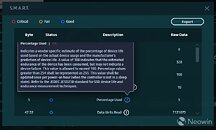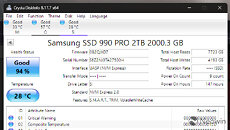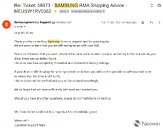- Joined
- Oct 9, 2007
- Messages
- 47,586 (7.45/day)
- Location
- Dublin, Ireland
| System Name | RBMK-1000 |
|---|---|
| Processor | AMD Ryzen 7 5700G |
| Motherboard | ASUS ROG Strix B450-E Gaming |
| Cooling | DeepCool Gammax L240 V2 |
| Memory | 2x 8GB G.Skill Sniper X |
| Video Card(s) | Palit GeForce RTX 2080 SUPER GameRock |
| Storage | Western Digital Black NVMe 512GB |
| Display(s) | BenQ 1440p 60 Hz 27-inch |
| Case | Corsair Carbide 100R |
| Audio Device(s) | ASUS SupremeFX S1220A |
| Power Supply | Cooler Master MWE Gold 650W |
| Mouse | ASUS ROG Strix Impact |
| Keyboard | Gamdias Hermes E2 |
| Software | Windows 11 Pro |
Samsung 990 PRO is the company's flagship client SSD, which is among the fastest Gen 4 NVMe SSDs you can buy. It also commands a very high price premium, with the 1 TB variant priced at $170, and the 2 TB variant at $290. When you're buying in this segment, you expect the highest endurance figures for your SSD. Client SSD endurance figures are already on the rise, as NAND flash technology evolves. Neowin noticed that their 990 PRO isn't meeting this vital expectation, and with a little digging, found that there are others with this problem, and they didn't just get a bad drive.
Apparently, the "drive health" reading in Samsung Magician—the utility software for Samsung SSDs—drops rather rapidly for the 990 PRO. After a clean software installation on a new drive, Neowin observed that their drive's health reading was already at 99% (something very unexpected for a new drive); and what's worse was that even with regular use of the drive in the following days, the drive health would drop by 1 percentage point every day. Drive health is interchangeable with endurance, as it indicates the number of program-erase (PE) cycles left on the NAND flash memory before regions of the drive's user-area become unwritable.



Such a rapid drop in endurance used to be a problem in the very first generations of client SSDs some 15 years ago, but it's highly unusual for a flagship product like the Samsung 990 PRO. This user on Twitter claims that their drive health dropped down to 64% at just 2 TB of total bytes written—something you don't expect even entry-level SSDs to end up with. Neowin's initial RMA request was rejected (the drive returned) as the company found "no defect" with it, but once it realized that it was dealing with the press, it quickly reached out to replace the drive and try to reproduce the issue.
View at TechPowerUp Main Site | Source
Apparently, the "drive health" reading in Samsung Magician—the utility software for Samsung SSDs—drops rather rapidly for the 990 PRO. After a clean software installation on a new drive, Neowin observed that their drive's health reading was already at 99% (something very unexpected for a new drive); and what's worse was that even with regular use of the drive in the following days, the drive health would drop by 1 percentage point every day. Drive health is interchangeable with endurance, as it indicates the number of program-erase (PE) cycles left on the NAND flash memory before regions of the drive's user-area become unwritable.



Such a rapid drop in endurance used to be a problem in the very first generations of client SSDs some 15 years ago, but it's highly unusual for a flagship product like the Samsung 990 PRO. This user on Twitter claims that their drive health dropped down to 64% at just 2 TB of total bytes written—something you don't expect even entry-level SSDs to end up with. Neowin's initial RMA request was rejected (the drive returned) as the company found "no defect" with it, but once it realized that it was dealing with the press, it quickly reached out to replace the drive and try to reproduce the issue.
View at TechPowerUp Main Site | Source




